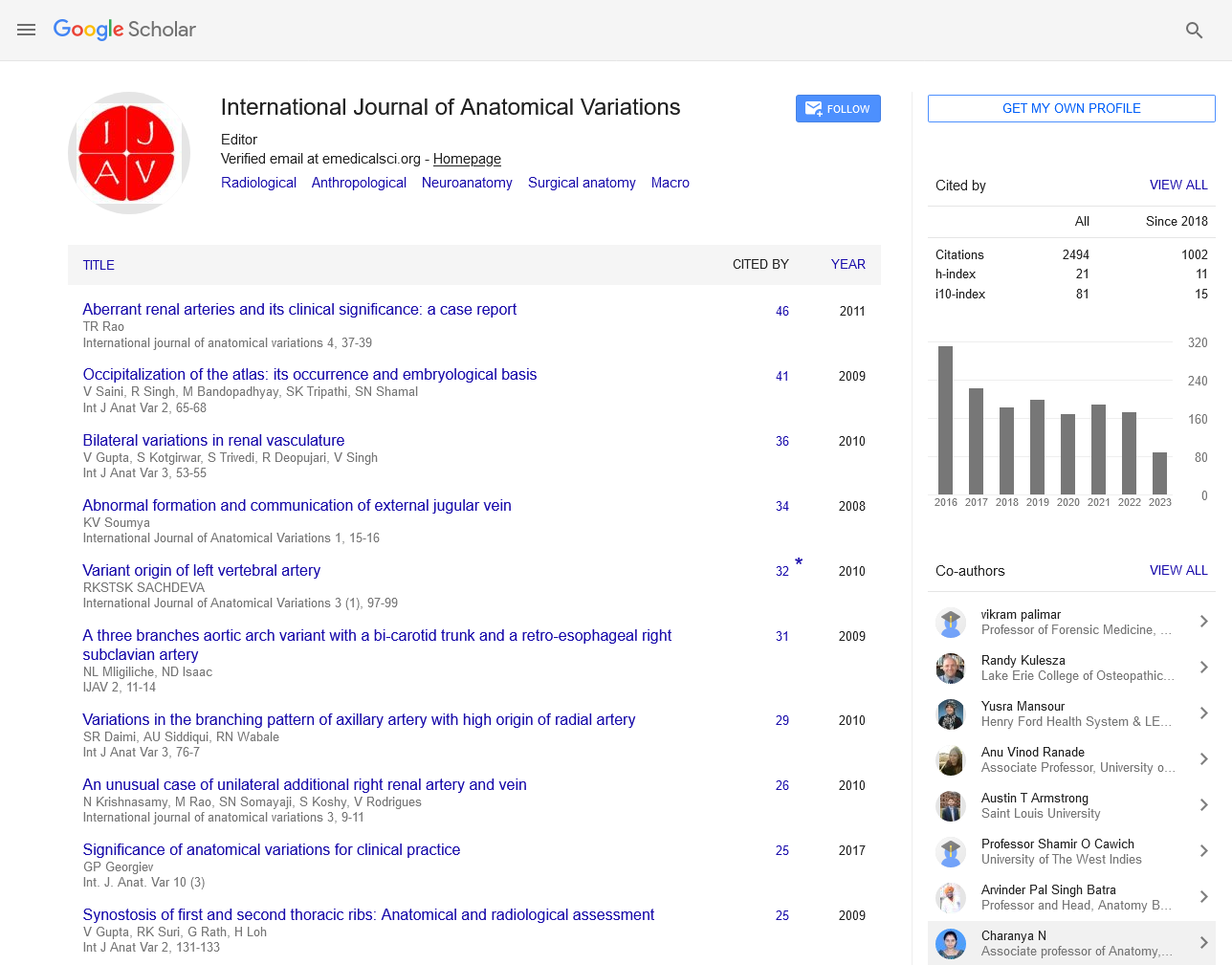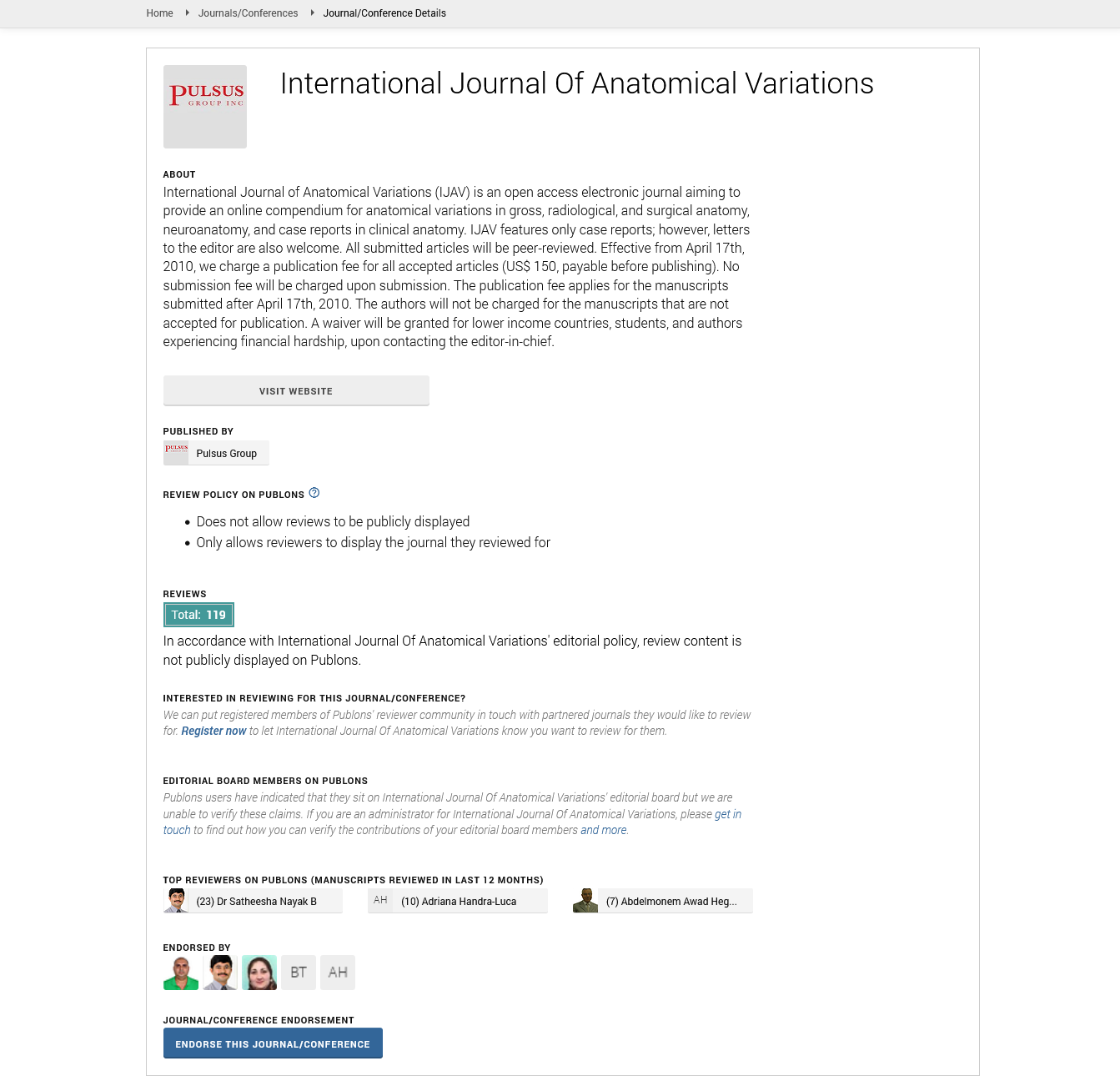Variations in the Structure of the Human Pelvis Impact on Obstetric Delivery and Pelvic Surgery
Received: 02-Dec-2024, Manuscript No. ijav-24-7363; Editor assigned: 04-Dec-2024, Pre QC No. ijav-24-7363 (PQ); Reviewed: 18-Dec-2024 QC No. ijav-24-7363; Revised: 26-Dec-2024, Manuscript No. ijav-24-7363 (R); Published: 31-Dec-2024, DOI: 10.37532/1308-4038.17(12).470
Citation: Hintermeier S. Variations in the Structure of the Human Pelvis Impact on Obstetric Delivery and Pelvic Surgery. Int J Anat Var. 2024;17(12): 709-710.
This open-access article is distributed under the terms of the Creative Commons Attribution Non-Commercial License (CC BY-NC) (http://creativecommons.org/licenses/by-nc/4.0/), which permits reuse, distribution and reproduction of the article, provided that the original work is properly cited and the reuse is restricted to noncommercial purposes. For commercial reuse, contact reprints@pulsus.com
Abstract
The structure of the human pelvis plays a crucial role in obstetric delivery and pelvic surgery. Variations in pelvic anatomy, whether congenital or due to trauma, can significantly impact childbirth and complicate surgical interventions. The pelvis consists of four bones and can be divided into the false pelvis and the true pelvis, with the latter forming the birth canal. Different pelvic types gynecoid, android, anthropoid, platypelloid, and cleft—each present unique challenges during labor. For example, android and platypelloid pelves may lead to obstructed labor, fetal malposition, and higher cesarean section rates, while anthropoid pelves can result in prolonged labor. Pelvic variations also affect pelvic surgeries, including reconstruction, trauma management, and pelvic floor repairs, requiring tailored surgical approaches. Understanding these anatomical differences is essential for clinicians to optimize delivery plans and surgical interventions, improving outcomes and reducing complications for both mothers and infants.
Keywords
Pelvic structure; Human pelvis; Obstetric delivery; Pelvic surgery; Pelvic anatomy; Pelvic variations; Childbirth; Caesarean section; Pelvic floor; Pelvic deformities
INTRODUCTION
The human pelvis is a complex structure that plays a pivotal role in both childbirth and overall body biomechanics. It serves as the foundation for the trunk and supports the weight of the upper body, while also accommodating vital structures like the reproductive organs, bladder, and rectum. The pelvis undergoes significant changes during pregnancy and childbirth, making its anatomy crucial in obstetric delivery. Variations in the structure of the pelvis, whether congenital or due to trauma, can influence the success and safety of obstetric deliveries and complicate pelvic surgeries. Understanding these anatomical differences is essential for clinicians to make informed decisions regarding delivery methods and surgical interventions. This article explores the different variations in the structure of the human pelvis and their implications for obstetric delivery and pelvic surgeries [1].
OVERVIEW OF PELVIC ANATOMY
The human pelvis is composed of four bones: the sacrum, coccyx, and the two hip bones (os coxae), each formed by the ilium, ischium, and pubis. The pelvis has two major divisions: the false pelvis (upper portion) and the true pelvis (lower portion), which forms the birth canal. The pelvic inlet, outlet, and cavity are key landmarks in understanding obstetric delivery. The pelvic inlet is the upper opening of the true pelvis, the pelvic cavity is the space below it, and the pelvic outlet is the lower opening. During labor, the shape and size of the pelvis play a crucial role in determining whether vaginal delivery is feasible or if a cesarean section is required. Structural variations in the pelvis can affect the passage of the fetus through the birth canal, leading to complications like dystocia, the need for forceps or vacuum assistance, or cesarean delivery [2].
TYPES OF PELVIC VARIATIONS
Gynecoid Pelvis
The gynecoid pelvis is considered the "ideal" pelvic type for vaginal delivery. It is the most common pelvic shape in women, characterized by a round or slightly oval pelvic inlet, a spacious pelvic cavity, and a wide pelvic outlet. This pelvic configuration facilitates the passage of the fetus during labor and generally has the least risk of obstructed labor or fetal malposition. In gynecoid pelves, the birth canal is adequately shaped and sized to allow for a smooth delivery [3]. However, while gynecoid pelves provide optimal conditions for vaginal delivery, variations in the degree of symmetry and subtle differences in bone structure can still influence the ease of delivery. These subtle variations may sometimes lead to difficulties in labor, but they generally have a lower impact on delivery outcomes compared to other pelvic types.
Android Pelvis
The android pelvis is more common in males but can be found in some females as well. This type of pelvis is characterized by a heart-shaped pelvic inlet, narrow pelvic cavity, and a relatively small pelvic outlet. The structure of the android pelvis can create significant challenges during labor, as it may obstruct the passage of the fetus through the birth canal. In women with an android pelvis, there is an increased risk of fetal malposition, such as occipitoposterior position (where the fetus’s back is facing the mother’s back), which can lead to prolonged labor and the need for surgical interventions. An android pelvis is also associated with a higher incidence of cesarean delivery due to the narrowness of the pelvic inlet and outlet. Obstetricians may need to closely monitor the progress of labor and intervene early if necessary [4].
Anthropoid Pelvis
The anthropoid pelvis has an elongated oval shape, with a larger anteroposterior diameter and a smaller transverse diameter. While the pelvic inlet is more oval-shaped compared to the gynecoid pelvis, the overall size of the pelvic outlet may still allow for vaginal delivery, especially if the baby is in the right position. Despite its generally favorable characteristics, the anthropoid pelvis can present challenges during labor. The increased anteroposterior diameter may lead to fetal head engagement in a more anterior position, causing difficulties in achieving a proper fit between the fetus and the pelvis. This can result in prolonged labor and the need for intervention, such as forceps delivery or cesarean section [5].
Platypelloid Pelvis
The platypelloid pelvis is characterized by a flattened, oval-shaped pelvic inlet, with a wide transverse diameter and a narrow anteroposterior diameter. This type of pelvis is relatively rare but can cause significant complications during obstetric delivery. The flat shape of the inlet can prevent the fetal head from properly engaging, leading to difficulties in descent and rotation during labor. Women with a platypelloid pelvis are at higher risk for obstructed labor, fetal malposition, and cesarean delivery. The narrow anteroposterior diameter often makes it challenging for the fetus to rotate during labor, leading to a greater likelihood of the fetus remaining in a non-optimal position, such as breech. Pelvic surgery may also be complicated in patients with a platypelloid pelvis due to the irregular shape of the pelvic cavity [6].
Cleft Pelvis
A cleft pelvis is a rare congenital anomaly where there is an incomplete fusion of the pubic bones, resulting in a gap or cleft at the pubic symphysis. This condition can cause significant pelvic instability and lead to abnormal positioning of the fetus during labor. The cleft may also lead to deformities in the pelvic inlet and outlet, making vaginal delivery difficult or impossible in some cases. In such cases, cesarean section is often necessary to avoid complications such as uterine rupture or fetal injury. Pelvic surgery in individuals with a cleft pelvis may require special techniques to address the abnormal bony structure, as the pelvis may be weakened or unstable. Depending on the severity of the cleft, corrective surgery may be considered to improve the stability of the pelvis [7].
IMPACT OF PELVIC VARIATIONS ON PELVIC SURGERY
Pelvic Reconstruction and Correction
Pelvic surgery can be complicated by structural variations in the pelvis. For example, patients with congenital anomalies such as a cleft pelvis or those who have experienced trauma may require pelvic reconstruction to restore normal anatomical function. The surgical approach must be carefully planned to address the specific deformity, whether it involves bone realignment, soft tissue repair, or joint stabilization.
In cases of pelvic floor prolapse, where the pelvic organs descend due to weakened support structures, understanding the patient’s pelvic anatomy is essential for selecting the correct surgical technique. Pelvic floor repair and organ repositioning often require precise knowledge of pelvic measurements and variations to minimize complications [8].
Pelvic Fractures and Trauma
Pelvic fractures resulting from trauma can be influenced by variations in pelvic structure. For instance, women with a narrow or abnormally shaped pelvis may be at higher risk for fractures during traumatic events such as accidents. Surgical repair of these fractures requires careful consideration of the pelvic anatomy to ensure the stability and functionality of the pelvic ring.
CONCLUSION
Variations in the structure of the human pelvis have significant implications for obstetric delivery and pelvic surgery. Pelvic shape and size play a critical role in determining the ease or difficulty of vaginal delivery, with certain configurations, such as the android or platypelloid pelvis, presenting more challenges. These variations can lead to increased rates of cesarean section, fetal malposition, and obstructed labor. In addition, pelvic variations impact the management of pelvic trauma and reconstructive surgery, requiring tailored surgical approaches to restore function and stability. By understanding and evaluating these anatomical differences, healthcare providers can optimize outcomes for both obstetric delivery and pelvic surgical interventions, ultimately improving the safety and well-being of both mothers and their infants.
REFERENCES
- Anri S, Masayoshi O, Shigeru H. Glomerular Neovascularization in Nondiabetic Renal Allograft Is Associated with Calcineurin Inhibitor Toxicity. Nephron. 2020; 144 Suppl 1:37-42.
- Foivos I, Jonathon K, Daryll B. Aberrant right subclavian artery - a rare congenital anatomical variation causing dysphagia lusoria. Vasa. 2021; 504(5):394-397.
- Schizas N, Patris V, Lama N. Arc of Buhler: A lifesaving anatomic variation. A case report. J Vasc Bras. 2012; 37(11):9-326.
- Mamikonyan VR, Pivin EA, Krakhmaleva DA. Mechanisms of corneal neovascularization and modern options for its suppression. Vestn Oftalmo. 2016; 132(4):81-87.
- Jun S, Zhang-Y, Chuan C. Postoperative neovascularization, cerebral hemodynamics, and clinical prognosis between combined and indirect bypass revascularization procedures in hemorrhagic moyamoya disease. Clin Neurol Neurosurg. 2021 Sep; 208:106869.
- Qi L, Xiaojie T, Yafang D. Evaluation of Carotid Plaque Rupture and Neovascularization by Contrast-Enhanced Ultrasound Imaging: an Exploratory Study Based on Histopathology. Transl Stroke Res. 2021 Feb; 12(1):49-56.
- Kuo-Shyang J, Shu-Sheng L, Chiung-FC. The Role of Endoglin in Hepatocellular Carcinoma. Int J Mol Sci. 2021 Mar 22;22(6):3208.
- Xin W, Bofu L. Aortic Dissection with Rare Anatomical Aortic Arch Variation Depicted by Computed Tomography Angiography. Heart Surg Forum. 2021; 24(2): E407-E408.
Indexed at, Google Scholar, Crossref
Indexed at, Google Scholar, Crossref
Indexed at, Google Scholar, Crossref
Indexed at, Google Scholar, Crossref
Indexed at, Google Scholar, Crossref
Indexed at, Google Scholar, Crossref
Indexed at, Google Scholar,, Crossref






